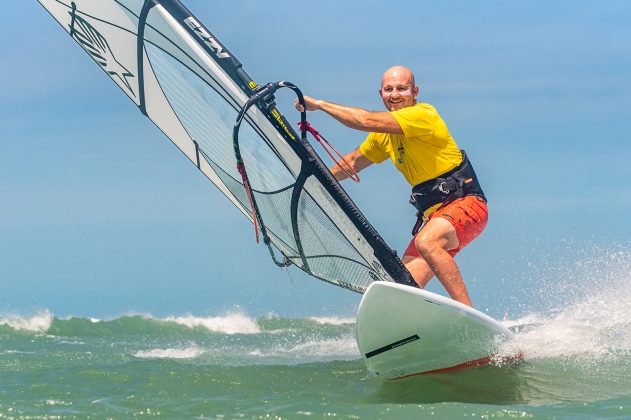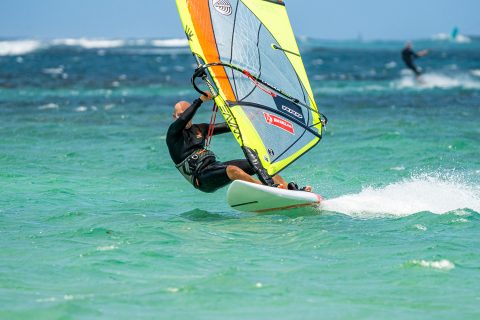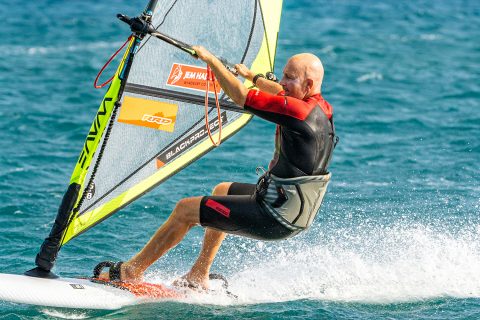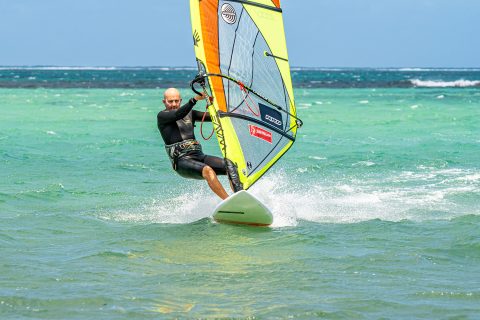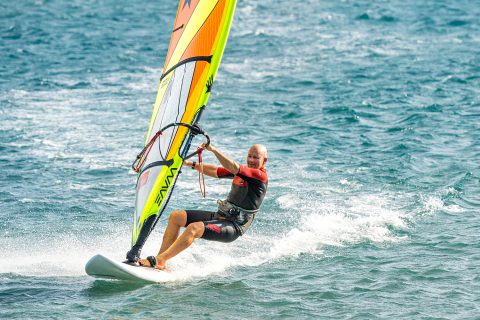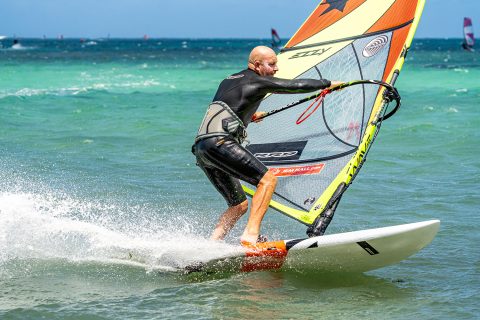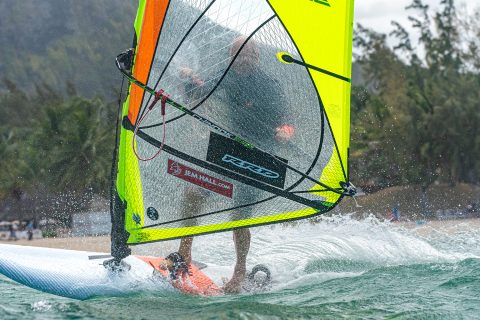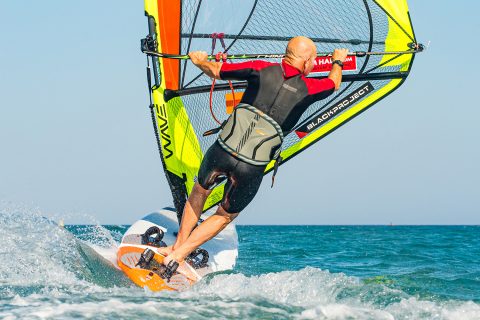JEM HALL
MOVE ON UP – WINDSURFING TECHNIQUE
BETTER GYBING
JEM HALL: BETTER GYBING
Jem explains how to turbo charge your gybe entry.
PHOTOS BY Eye Sea You Photo.
If I ask a group of ‘windies’ what is the most important action in the carve gybe? Nearly all say “Speed” and they are in effect right. Yet the actual answer is Precise Preparation and Back Hand Back (BHB). In my quest to help you gybe better I have examined what needs to be focused on to achieve this, and so this article is all about how to get, and crucially keep, more speed going into the gybe, so you then have more speed in the next phases. After all, how we start is how we end, so if we go in with speed we have momentum to maintain a wider arc, which can then give us more time to go though the phases and thus have more speed in the exit.
- Low, out and down will make your lines tight and easier to unhook with a subtle bend of the elbows.
Devil is in the detail
We can break down the preparation phase of the gybe with my tried and tested H.U.F. principle. As stated earlier, it is precision in this that will really boost your gybe entry speed and you can add to that plenty of power, or Oooommpphh. Not from the wind, but from you harnessing it, committing to it, and then transferring it into board speed.
Let’s look at the H.U.F. parts:
- H is Back Hand Back (BHB): this is huge and has been covered in my “Handy Hints” piece in the June ’22 issue. If you move your BHB for gybes, and many other moves, we gain so many advantages. In the prep. part of the gybe it enables you to have leverage over the rig once unhooked, as this is the part where a lot of speed is lost.
- U is for Unhook: if the previous part can be neglected too many times then this is your real “opportunity to improve”. Unhook from a low, outboard and committed position by ONLY bending your elbows. This keeps you low and down. Raising your hips to unhook, as some do, will see you losing speed, and risking staying hooked in and then catapulting.
- F is for Foostrap; this is the action of taking your back foot out of the strap. You need to be precise in not only how you get it out, but also where you put it. Your new plan is to take it out and put it in the middle of the board, right next to the back strap. With the Back Foot Back (BFB) you then scissor and get speed and after this then move it onto the rail for carving. This has been an absolute game changer in my last 2 years of coaching.
So there you have it. If you really focus on these small precise actions they will become more effective, efficient and consistent and all of these qualities will yield progress.
- FHB, BHB, back foot back whilst keeping outboard to sheet the sail in will all boost your entry speed.
Here are a few drills to help:
- BHB drills: do a lot of light wind skills and drills, and gybes and steering. Or whilst blasting, across the wind, stay low and sail fast whilst moving your back hand up and down the boom.
- Unhook drills: aim to really improve at unhooking by doing it across the wind whilst blasting. Really focus on staying low and sailing fast and thinking ‘tight lines’ or ‘lines like piano strings’ and unhook by only bending your arms. EXTRA TIP: ensure your harness is very tight as this facilitates slick unhooking.
- In and out: concentrate on really pulling down on the boom to get your foot not only in the straps after planing, but also when getting them out. You can smoothen this by transferring more weight to the foot that is not going in or out of the strap. Unhook and take out the back foot like you are going to gybe (BFB), keep speed and then put it back in, hook in and carry on. The better you are at sailing fast unhooked and out of the back strap, the better you will be at gybing!
- Speed is ok here, but my sail is too open and I am not outboard enough to scissor.
Trust the power
We have looked at precision in our preparation so let’s now look at ways to bring more power into your sailing, in order to get you transferring the power though your body and into the board to maintain the all so precious speed we need to carve gybe.
Two key areas that we can work on is our physicality and our mindset so we can then handle this power, not just a few times but many times over in a session.
Here are some tips and drills:
- Believe: in order to sail fast unhooked in a windy session we already need a positive self-dialogue walking down to the water, as we launch and throughout this session. Essentially, even when overpowered, you need to be “comfortable with being uncomfortable”.
- Fake Gybe: I named this the J(G)ack, thanks to Simon Laidler, and it is a great move to do when well powered up and you just don’t fancy going on to do the carve after your prep and sailing so fast unhooked. So after doing the prep to gybe, you then head back across the wind and do a tack. It builds belief, and technique in your turbo boosted preparation.
- Sailing overpowered: I have been advising this drill a lot when the wind comes up and many of the group are overpowered on flat water. I suggest that people tension their sails and just sail 8-10 reaches really overpowered and not worry about how they can turn round – they can tack, or jump in the water and waterstart back the other way. This really builds excellent control skills and if you have these then you feel way more confident unhooking from a low committed position as you are used to dealing with all this power, and at speed.
- Being low and outboard means you can scissor downwind to get speed, with the wake line evidence of this.
Two steps please
This double movement of the back foot has been a game changer and it all started with me trying to find a way to get more of my people gybing faster and thereby on the front foot.
This is the same technique for all boards and all winds, be it non-planing, or bigger boards and sails and on flat water or in strong winds and on smaller boards. The only difference is the length of the approach (gaining speed and lightening of the rig), i.e. shorter in high winds so you are ready to carve off a bit of swell or wave, and a longer approach on bigger gear / flatter water.
I feel I must sell you why moving your back foot twice works, here is some reasons.
- Less upset: going to the middle of the board with your BFB first upsets it less, keeps it flat and maintains speed and stability.
- No going early: if your back foot is in the middle it stops you going straight into the carve. This then means you are well placed to gain speed and lighten the rig by scissoring, as opposed to unhooking and going straight to the rail, then heading straight into a carve without enough speed to pull a good gybe off.
- All the way: going to the middle and then sliding the foot to the rail ensures you get your back foot all way to the rail so you can carve from a better position to depress the rail.
- Give me some space: having your back foot all the way back ensures your feet are better placed for the footwork, with plenty of space, for your exit phase when the new back foot carves out on your heel.
- I need some time: moving your foot twice gives you more time so you can focus on each positive action in turn, rather than rushing it. A good windsurfer looks to make time and use space wisely for themselves.
- Taking speed into the gybe, through scissoring means the rails are ready to carve.
Scissor it
Scissoring is a crucial skill that we should all be doing a lot more. It is the action of our legs moving in opposing directions, this can be pushing the board downwind to plane, or turning off the wind in the air, or heading upwind to tack or carving upwind in a ride. Three of the biggest inhibitors to successful gybes are the back hand not being back, poor unhooking, and the absence of scissoring to turn downwind and then accelerate.
If you have unhooked from a low outboard position you are well placed to put some subtle weight through the front foot and push the nose downwind as you gently pull in on the back foot. If you are outboard you can scissor, and before this you can keep speed, so as I say to some people, ‘get your arse in the sea!’ You can scissor and then either target a distance to sail, or count to 2-3 seconds on flat water, but you must have the ‘Eureka’ moment of feeling the rig go light and then embrace and enjoy it.
Why should you scissor?
- Speed: turning downwind with a flat board, not with the carving rail depressed, will keep speed and give you more space and time and make a nice arc.
- Lighten up: getting the speed in pre-gybe will make the rig go light so it is easier to handle.
- So ready: board speed helps the rails to be ready and itching to carve. Slow speeds can see the rails catch and trip and throw you off.
- BHB pre gybe helps you both in the entrance and mid part of the gybe, and with the BFB and on the rail you can depress the rail to carve better.
Kit Tuning and Recommendations:
Tape it: place some tape waaaaay back on the boom to ensure you feel the back hand go over it and then you will know the back hand is really back.
Long lines will facilitate easier unhooking, enable unhooking from a low outboard position, and give you more speed in a straight line prior to the gybe.
Generous straps allow your feet to get out of the footstraps smoothly and to then carve with bent ankles. We want footstraps, not toestraps!
Freemove boards, or big Freestyle wave boards give you stability and help you keep momentum for the all important entry speed.
Aim to have not too much fin so the board is controllable and responsive, e.g. 35 cm fin for me with a 6.5 on a 110 litre Freemove. Or a big tri-fin set on a Freestyle wave, like 11 cm sides and a 21.5 to 20 cm main fin.
- Start well to end well! With your BHB and BFB you have space for your footwork for a good exit.
Ezzy sails, RRD (boards, wetsuits & softwear), Chinook & Black Project fins sponsor Jem Hall. Get him live and direct on one of his highly acclaimed coaching holidays – check out his website www.jemhall.com for details. You can also follow him on twitter / Facebook / Instagram.


